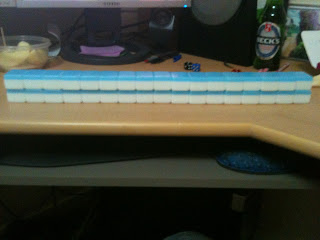Since I play by Japanese rules, the procedure to set up slightly varies from traditional old style Hong Kong (Which is what most people who play the game are familiar with). Either way, the goal is achieved.
First you need 4 players. You could get by with 3, which we call "Three-legged Mahjong" but those kinds of games are dull. Personally I never play with less than 4.
Shuffle one tile of each of the directional tiles (East, South, West, North) and each person will pick one. That will determine where each player sits. The important thing is not where the player sits, but where they sit relative to other players. The South player sits to the right of the East player; the West player sits to the right of the South player; the North player sits to the right of the West; and the East player sits to the right of the East player.
After seating is determined, all the tiles are shuffled and each player forms a wall of 17 (18 in Hong Kong Style because they use Flowers) x 2 tiles.
Then you take one wall, and lift it on top of the other:
Most beginners can't accomplish this, so they either stack the second wall on top, or they do it piecewise. Lifting the second wall on top of the first wall is one of those skills you learn just by playing enough.
After the walls are formed, each player pushes it near the center, forming a "windmill" shape.
Due to the size of my work table, I can't make the full windmill, but from this you should see the basic principle.
The dealer (East player) rolls two dice to determine which wall to take from.
For example the dealer rolled 5. Count counter clockwise starting with yourself as 1. After counting, we determine that it is him/herself that we take from. Many people don't even need to count and just memorize the possible outcomes (1, 5, 9 is yourself for example) or take a mathematical approach (1 + 4n = self, where n = number of full cycles).
Observant people will notice that the dice and where the wall is broken do not match. To be honest this is a really arbitrary process, so for the most part it doesn't matter. It was just easier to take a picture this way.
The player who was chosen will then count the number of stacks, starting from their right, the number rolled. They count 5 stacks (each stack being 1 x 2) starting from their right end (another way to think about it is go clockwise). After counting the rolled number, the wall is "broken" starting with the next number (in this case 6).
Now count 7 stacks from the right of where you broke the wall. These 7 stacks are the "dead wall". If there are not enough stacks, take the remainder from the next wall.They are used to indicate Dora and to draw when someone gets a Kan. Starting from the left side of the dead wall, flip the third tile upward; this tile is the Dora indicator (I will go in depth with Dora and scoring in another post).
Finally, going back to the original wall break, the dealer takes two stacks (2 x 2), then the player on the left (North player) takes the next two stacks, and so on until each player has 6 stacks (or 12 tiles in total). Then the dealer takes 1 tile, "skips" the second, and takes the third. North, West, and South then take one tile in order. This way, the dealer has 14 tiles to start, while everyone else has 13.
The game begins after everyone finishes organizing their tiles and the dealer deals one of his tiles. Turns go counter-clockwise, so South player begins his turn by drawing a tile from the wall, and then discarding a tile. The game goes on like this until either someone wins, or the dead wall is reached (It is dead because you aren't allowed to take any tile from there, except when you get a Kan). The game can also end under special circumstances, which won't be went over right now.
Rotation of dealer, duration of rounds, and more complex mechanics will be another time.
This was a really sloppy job, but I have a much better time playing than setting up (don't we all?).









No comments:
Post a Comment